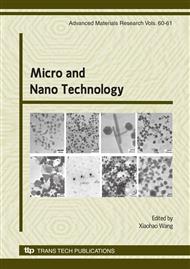p.343
p.347
p.353
p.357
p.361
p.367
p.371
p.375
p.380
Electrical Trimming of Boron-Doped Polysilicon Nanofilm Resistors Deposited at Different Temperatures
Abstract:
The previous research showed that highly doped polysilicon nanofilms (PSNFs) have a high gauge factor and stable temperature characteristics, promoting their applications in piezoresistive sensors. For correcting the resistance deviation and improving the resistance matching of sensing elements, the electrical trimming (ET) characteristics of PSNFs deposited by LPCVD at different temperatures were studied. By the interstitial-vacancy (IV) model, the resistance falloff in trimming phenomenon is considered as a result of the decrease of scattering centers caused by the recombination of IV pairs. By modeling grain boundaries (GBs) as the accumulation of IV pairs (basic defects), it is believed that IV pairs can recombine layer-by-layer under the energy excitation of joule heat generated by high current conduction. The experiment results show that the threshold current density for ET of PSNFs is an order of magnitude lower than that of polysilicon common films, while the trimming accuracy and stability of directly deposited PSNFs are superior to the recrystallized ones. Finally, it is gained that reducing amorphous phases at GBs by optimizing deposition temperature can improve ET characteristics of PSNFs.
Info:
Periodical:
Pages:
361-366
Citation:
Online since:
January 2009
Authors:
Price:
Сopyright:
© 2009 Trans Tech Publications Ltd. All Rights Reserved
Share:
Citation:


